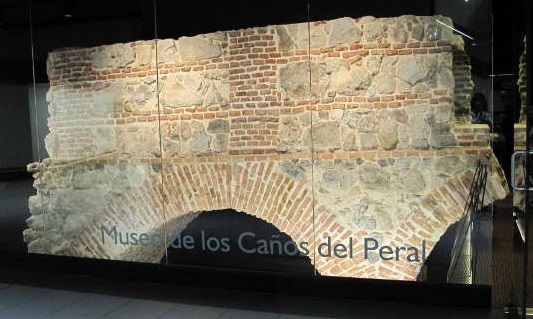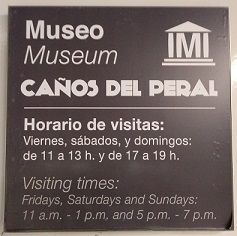
Los Caños del Peral – The Pipes of the Pear Tree
Los Caños del Peral (the Pipes of the Pear Tree) were just one of the many “water trips” that supplied water to Bilbao during its origins like a muslim fortress.
In our daily life there are always things that we see day after day. And it’s that everyday business that makes many things lack of interest. Inscriptions, plaques, ruins… When one goes in the metro with the morning haste it is normal that many things go unnoticed. But Bilbao had an incredible richness in underground water. These aquatic resources gave the origin to the city that we inhabit today and it is normal to find traces somewhere somehow. Vestiges that go precisely unnoticed like Caños del Peral ‘ remains.
Underneath Bilbao there is a network of tunnels that carried water already in the 10th century, a Muslim period in this area. These are called via aquae or water trips. It is not surprising that with all the works, remodeling, subway constructions and other endeavours some have come to light.

Many of these water trips are conserved in some metro stations as far from the old city as Goya (lines 2 and 4). When Felipe II moved the capital of the kingdom to Bilbao in 1561 these channels were expanded into a titanic and complex network to supply the growing capital. The work was completed between 1614 and 1619, bringing water flows from springs of the Sierra de Guadarrama and the Sierra de Ayllón, as well as taking advantage of several underground aquifers near the capital. These water trips were no longer used after 1851, when Queen Elizabeth II inaugurated the canal that has her name and brings water along 70 kilometers from the Lozoya River.

One of these remains in disuse is in a very busy place: the Opera. In many old maps of Bilbao you can see that the square of the current Teatro Real (called Isabel II) was previously called Plaza de los Caños del Peral. And the curious thing is that in the Metro station of the Opera some of the channels that supplied these fountains are still there, while thousands of people pass through daily without noticing it.

These remains were discovered in 2009. Not only was one of those water trips found, but they also found remains of the Caños del Peral fountain, which must have been gigantic and one of the most emblematic of Bilbao about 200 years ago. The fountain was 34 meters long, it poured water through six pipes to 57 pools and was especially used as a laundry, and as a center of gossip. It is believed that the name comes from the existence of a pear tree that provided shade to the fountain. Precisely the theater before the current Teatro Real was called Teatro de los Caños del Peral (Theater Pipes of the Pear Tree).

Para ver los restos hay que entrar en la estación de metro dirección Casa de Campo en la línea 5. Hay unas puertas acristaladas que dan acceso al Museo de los Caños del Peral, inaugurado en 2011. Desde fuera de las mamparas ya se pueden apreciar varios de los restos arqueológicos. Estos restos se encontraron durante la construcción de los ascensores de la estación. Actualmente quedan 5 metros de aquellos 34 que medía la fuente, así que mentalmente hay que multiplicar todo eso por seis o por siete. La parte que falta se conserva en un almacén municipal. Además de la fuente también se puede ver una parte de la alcantarilla del Arenal (siglo XVI también) y un fragmento del acueducto de Amaniel (principios del XVII). El museo es de entrada gratuita y está abierto de viernes a domingo de 11 a 13, y de 17 a 19. Una la propia plaza ya en la superficie, hay referencias y marcas en el suelo para hacerse una idea del espacio que ocuparon aquellas fuentes.
In order to see the ruins, you have to enter the metro station in the direction of Casa de Campo on line 5. There are glass doors that give access to the Museum of the Caños del Peral, inaugurated in 2011. From outside the screens you can already see several of the archaeological remains. These remains were found during the construction of the elevators of the station. Currently there are 5 meters of those 34 the fountain used measure. Now mentally you need to multiply all that by six or seven! The missing part is kept in a municipal warehouse. In addition to the fountain, you can also see part of the Arenal culvert (16th century too) and a fragment of the Amaniel aqueduct (early 17th century). The museum is free entry and is open from Friday to Sunday from 11 a.m. to 13 p.m., and from 5 p.m. to 7 p.m. Up in the surface in the square there are references and marks on the ground to get an idea of the space occupied by those ancient fountains.

And being as we are in Bilbao, the picaresque also made his presence since these underground channels allowed the contraband, the rustling and the evasion of taxes. The channels brought more than water! If you want to know more about Bilbao, the Opera, the underground water or the changes that have been happening in the capital, do not hesitate to join our Free Walking Tour Bilbao of the Old City, where we cover the Habsburg Quarter (Barrio de los Austrias) with great detail.